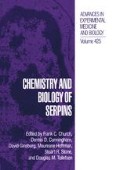Abstract
Members of the serpin superfamily have been identified in several invertebrate species, primarily as proteins in the hemolymph of animals from the phylum Arthropoda9. Serpin cDNAs have been cloned from horseshoe crabs14,15, a crayfish13, two species of lepidopteran insects6,10,17,20,24, the fruit fly Drosophila melanogaster 3, trematodes from the genus Schistosoma 2, and from a parasitic nematode25. The presence of serpins with differing proteinase inhibitory activities in the hemolymph of horseshoe crabs and insects suggests that serpins may function in several physiological processes in invertebrates, as they do in mammals. The number of invertebrate species vastly exceeds the number of vertebrates, with far greater biological diversity. Thus, it may be predicted that as biochemical studies on invertebrates progress, a large number of serpins with diverse activities and functions will be discovered. In our research on serpins from the tobacco hornworm, Manduca sexta, we have identified a family of serpins with different inhibitory activities, and a unique serpin gene structure for generating reactive site diversity.
Access this chapter
Tax calculation will be finalised at checkout
Purchases are for personal use only
Preview
Unable to display preview. Download preview PDF.
References
Ashida, M. and Sasaki, T. (1994) A target protease activity of serpins in insect hemolymph. Insect Biochem. Mol. Biol. 24: 1037–1041.
Blanton, R. E., Licate, L. S. and Aman, R. A. (1994) Characterization of a native and recombinant Schistosoma haematobiumserine protease inhibitor gene product. Mol. Biochem. Parasitol. 63: 1–11.
Coleman, S., Drähn, B., Petersen, G., Stolorov, J., and Kraus, K. (1995) A Drosophilamale accessory gland protein that is a member of the serpin superfamily of proteinase inhibitors is transferred to females during mating. Insect Biochem. Mol. Biol. 25: 203–207.
Hanneman, E. and Kanost, M.R. (1992) Differential alaserpin expression during development of the antennae in the tobacco hawkmoth, Manduca sexta. Arch. Insect Biochem. Physiol. 19: 39–52.
Iwanaga, S. (1993) Primitive coagulation systems and their message to modern biology. Thromb. Haemostas. 70: 48–55.
Jiang, H., Wang, Y. and Kanost, M. (1994) Mutually exclusive exon use and reactive center diversity in insect serpins. J. Biol. Chem. 269: 55–58.
Jiang, H.B., Mulnix, A.B. and Kanost, M.R. (1995) Expression and characterization of recombinant Manduca sextaserpin-1B and site-directed mutants that change its inhibitory selectivity. Insect Biochem. Molec. Biol. 25: 1093–1100.
Kanost, M.R. (1990) Isolation and characterization of four serine proteinase inhibitors (serpins) from hemolymph of Manduca sexta. Insect Biochem. 20: 141–147.
Kanost, M.R. and Jiang, H. (1996) Proteinase inhibitors in invertebrate immunity. pp. 155–155, In “New Directions in Invertebrate Immunology” (Eds., Sëderhäll, K., Iwanaga, S., and Vasta, G.R.) SOS Publications, Fair Haven, NJ.
Kanost, M., Prasad, S. and Wells, M. (1989) Primary structure of a member of the serpin superfamily of proteinase inhibitors from an insect, Manduca sexta. J. Biol. Chem. 264: 965–972.
Kanost, M., Prasad, S., Huang, Y. and Willott, E. (1995) Regulation of serpin gene-1 in Manduca sexta. Insect Biochem. Mol. Biol. 25: 285–291.
Katsumi, Y., Kihara, H., Ochiai, M. and Ashida, M. (1995) A serine protease zymogen in insect plasma. Purification and activation by microbial cell wall components. Eur. J. Biochem. 228: 870–877.
Liang, Z. and Séderhäll, K. (1995) Isolation of cDNA encoding a novel serpin of crayfish hemocytes. Comparative Biochemistry and Physiology B, 112: 385–391.
Miura, Y., Kawabata, S. and Iwanaga, S. (1994) A Limulusintracellular coagulation inhibitor with characteristics of the serpin superfamily. J. Biol. Chem. 269: 542–547.
Miura, Y., Kawabata, S., Wakamiya, Y., Nakamura, T. and Iwanaga, S. (1995) A Limulus intracellular coagulation inhibitor type 2. Purification, characterization, cDNA cloning, and tissue localization. J. Biol. Chem. 270: 558–565.
Morisato, D. and Anderson, K.V. (1995) Signaling pathways that establish the dorsal-ventral pattern of the Drosophilaembryo. Annu. Rev. Genetics 29: 371–399.
Narumi, H., Hishida, T., Sasaki, T., Feng, D. and Doolittle, R. (1993) Molecular cloning of silkworm (Bombyx mori)antichymotrypsin. A new member of the serpin superfamily of proteins from insects. Eur. J. Biochem. 214: 181–187.
Pino-Heiss, S. and Schubiger, G. (1989) Extracellular protease production by Drosophilaimaginal discs. Dev. Biol. 132: 282–291.
Sasaki, T. (1985) The reactive site of silkworm hemolymph antichymotrypsin is located at the COOHterminal region of the molecule. Biochem. Biophys. Res. Commun. 132: 320–326.
Sasaki, T. (1991) Patchwork-structure serpins from silkworm (Bombyx mori)larval hemolymph. Eur. J. Biochem. 202: 255–261.
Sasaki, T. and Kobayashi, K. (1984) Isolation of two novel proteinase inhibitors from hemolymph of silkworm larva, Bombyx mori. Comparison with human serum proteinase inhibitors. J. Biochem. 95: 1009–1017.
Sasaki, T., Kohara, A., Shimidzu, T. and Kobayashi, K. (1990b) Single site proteolysis in silkworm antitrypsin causes structural changes in behavior against denaturing reagents. Agric. Biol. Chem. 54: 139–145.
Sëderäll, K., Cerenius, L., and Johansson, M.W. (1994) The prophenoloxidase activating system and its role in invertebrate defense. Annal. New York. Acad. Sci. 712: 155–161.
Takagi, H., Narumi,H.Nakamura, K. and Sasaki, T. (1990) Amino acid sequence of silkworm (Bombyx mori) hemolymph antitrypsin deduced from its cDNA nucleotide sequence: Confirmation of its homology with serpins. J. Biochem. 108: 372–378.
Yenbutr, P. and Scott, A.L. (1995) Molecular cloning of a serine proteinase inhibitor from Brugia malayi. Infect. Immun. 63: 1745–1753.
Author information
Authors and Affiliations
Editor information
Editors and Affiliations
Rights and permissions
Copyright information
© 1997 Springer Science+Business Media New York
About this chapter
Cite this chapter
Kanost, M.R., Jiang, H. (1997). Serpins from an Insect, Manduca sexta . In: Church, F.C., Cunningham, D.D., Ginsburg, D., Hoffman, M., Stone, S.R., Tollefsen, D.M. (eds) Chemistry and Biology of Serpins. Advances in Experimental Medicine and Biology, vol 425. Springer, Boston, MA. https://doi.org/10.1007/978-1-4615-5391-5_15
Download citation
DOI: https://doi.org/10.1007/978-1-4615-5391-5_15
Publisher Name: Springer, Boston, MA
Print ISBN: 978-1-4613-7461-9
Online ISBN: 978-1-4615-5391-5
eBook Packages: Springer Book Archive

